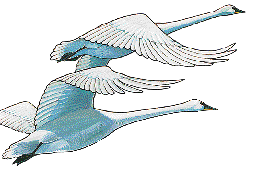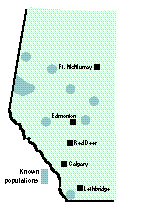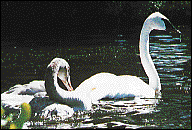 The
Trumpeter Swan (Olor buccinator)
The
Trumpeter Swan (Olor buccinator)
 The
Trumpeter Swan (Olor buccinator)
The
Trumpeter Swan (Olor buccinator)
Status: Trumpeters are the rarest swan in the world. They used to be abundant in North America but by the early 1900s, they were nearly extinct. Huge numbers had been shot for their down, feathers or meat. Increasing settlement disturbed suitable nesting areas.
An international restoration program began in the 1930s and trumpeter swans have responded well. They are still considered vulnerable in Canada, with about 550 swans nesting in Yukon, northern B.C., southwestern N.W.T. and the Grande Prairie/Peace River region of Alberta.
Appearance: This species is the largest swan in the world. It is white with a long neck it stretches straight out in front while in flight.
Behavior: The birds arrive in Alberta in April and move north as the lakes and sloughs open in the spring. Fall migration starts at freeze-up in October or November. They fly south only as far as they need to find an area of shallow lakes and streams with food and open water.

Food: Aquatic plants and insects, snails. Adults eat up to 9 kg each per day. Their long necks and powerful bills allow them to reach down and pull up roots and stems other birds can't reach.
Breeding: Trumpeter swans usually mate for life. Their big, bulky nests are mounds of reeds, rushes, roots and grasses lined with fresh swan's down. They're often built on top of beaver lodges, muskrat houses or small islands.
In mid-May, the female lays five or six eggs which she incubates until they hatch about 32 days later. The cygnets stay in the nest only about 24 hours until they can keep themselves warm. They have very little food reserve and must quickly start feeding.
Adult swans are flightless for about a month when they moult in the summer. As a result, male and female trumpeters moult at different times so one adult in a breeding pair will be able to fly while the other stays with the cygnets.
Lifespan: Up to 35 years in captivity, 12 years in the wild.
Risk factors: The major limiting factor affecting Alberta trumpeters is the size of their wintering area, a 15-km section of the Snake River in eastern Idaho. They must compete for food in this small area with other migratory trumpeters and birds that live there all year. As a result, some birds may be in poor condition by spring. They lack energy for migration, egg laying and incubation.
Other problems include human disturbance and recreational development in nesting areas.

Management and Outlook: Overall, trumpeter swans in North America are a conservation success story. Their outlook is bright.
* Biologists in the U.S. are trying to relocate wintering birds from the Snake River to other suitable habitats in Wyoming, Utah and southern Idaho.
* Since 1987, Canadian biologists have attempted with some success to re-introduce trumpeters to their former breeding area in Elk Island National Park. They take family groups from around Grande Prairie, then mark and release them in the park. The adults will return to Grande Prairie the following year while the young will return to the park, where they learned to fly.
* Trumpeters breed well in captivity. Young from a small flock at Camrose are being fostered back to the wild.
All swans in Canada are protected. Killing them is illegal.
Want to help? Join or Make a Donation to an Organization that makes a difference.
If you live in the united states, these green links will take you to organizations that make a difference there.